Training with Power at Interbike
By Chris Newport, Head Coach & Sports Nutritionist
As an endurance coach, it’s important to stay up to date on the latest training tools, metrics and industry changes.
But let’s face it, no matter what industry you’re in, sometimes you find yourself with your head buried, just trying to survive on day-to-day life.
Well, I knew there’s so much more I can be bringing to my athletes.
Visiting Interbike, through the eyes of a Coach
I’m always on the hunt to find continuing education opportunities, especially if they don’t involve staring at a computer screen. I found a unique opportunity to not only earn continuing education credits through Slowtwitch cycling’s power certification, but to also attend Interbike, the cycling industry’s main annual trade show.
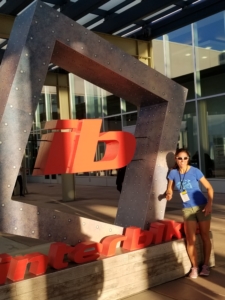
Coach Chris at Interbike 2018
I got to meet and hang out with some of the best coaches in the country. Both days, we started in the classroom, reviewing power, testing techniques, data analysis and more. Then we headed to Interbike and met with multiple powermeter manufacturers to see what was on the market and what’s the best options for you, our athletes.
Being an exercise physiologist and coach for over 13 years, most of the science was review (everything from NP, FTP, VO2Max, OBLA, TSS, and more). But using different methods of data analysis to better manipulate athletes’ exercise programming (as we like to call it, their “schedules”) for them to improve (aka get better, faster and stronger) was pretty cool.
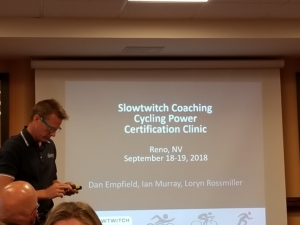
Coach Ian Murray leading day 1 in the clinic
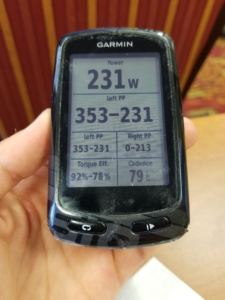
Watching a live 20 minute FTP test on the Garmin computer
Secondly, being able to hear each manufacturer talk about their product (each of them naturally being “the best in the industry”) and actually see them in action was great. We visited Stages, Wahoo, SRM, 4iiii’s, Wattbike, Garmin, Rotor, SRAM, Shimano, Pioneer, and Infocrank.
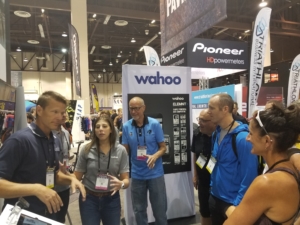
At the Wahoo booth
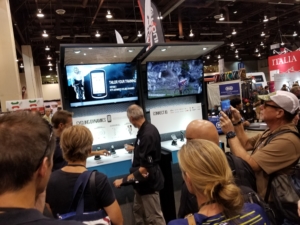
Visiting the Garmin booth
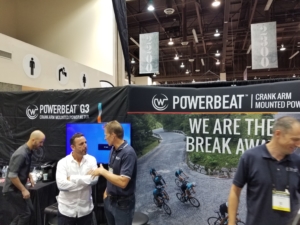
Learning about Wattbike. Very affordable, but installation and calibration is done by the rider
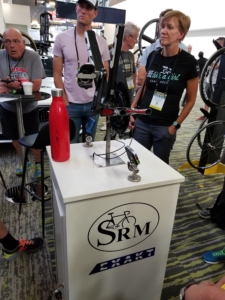
Visiting the SRM booth. Their custom head units are beautiful!
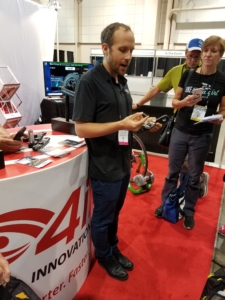
Learning about the 4iiii’s product out of Canada from a former pro triathlete
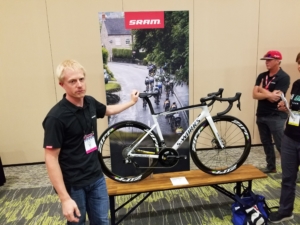
Our final visit to SRAM to learn about Quark (they’re beasts!)
But let’s rewind a second…
What exactly is power and why should I care as a cyclist or triathlete?
Power is way of quantifying work done on the bike.
Here’s the equation:
Torque x cadence = power
It eliminates the need to rely on speed (miles per hour), which is truly an arbitrary measure. There are so many factors that affect speed like aerodynamics, bike weight, road quality, wind, drafting, and more.
Power tells it like it is.
For example, when an athlete tells me that she “felt great today, but only did x mph,” then I look at her power file and can make an objective analysis on their effort based on their average power, normalized power, percentage of FTP/Max, intensity factor, variability index, and more.
Plus, it’s a real time measure of work, whereas heart rate has a lag time.
That’s not to say that heart rate isn’t a valuable indicator (assuming you have context for the numbers), but it’s a physiologic response. In fact, it’s practically useless when doing high intensity, short burst intervals under 2 minutes. But since we’re working with endurance athletes, being able to perform at a high level for a long duration is paramount and should be appropriately trained.
Plus, power gives athletes parameters. For triathletes, it’s a great method of ensuring you have a great run off the bike. Or it can be a way to push yourself enough during interval workouts.
How to increase your power
Remember the power equation (torque x cadence = power)?
To increase power, you need to work on increasing torque or cadence (or both) using proper overload, or the external training stimuli necessary to elicit a physiological internal response.
And that’s the fun part for me and my team. We take the science of power (and other measures like cardiorespiratory fitness, or VO2Max, strength, flexibility, nutrition, blood labs, and more) combined with the “art of you” and create our unique, magic formula to help you improve.
How to start training with power
Want to know how to start training with power?
Just jump in!
Buy a powermeter used or new (support your local bike shop!), but try to get your hands on whatever you can. If you have multiple bikes, then you can play with different meters (the actual device that’s collecting the data) and head units (which is displaying your data to you on your stem or handlebars).
Most of them are easy to install (or cheap to have someone do it for you) and waterproof, with decent battery life (some rechargeable and some with replaceable batteries) and are Bluetooth and ANT+ enabled.
They come on (or in) your crankarm (so you’ll need to know what size you need), pedals, or spider (or hub, but we didn’t visit any of those vendors) and are priced anywhere from $400 to $2500+. You can save money on right/left pedal balance, in my opinion, which is only (maybe) relevant to someone who might have specific imbalances in their lower limbs like feet, ankle, knee or hip injuries or surgeries.
Once you’re all set up, go ride!
Conducting a testing protocol gives you a great benchmark to measure improvement, but it’s not necessary (although it is for us!). The important thing is that you ride often (indoors and outdoors, if possible). The more you ride, the more data you’ll collect, in turn, the more you’ll learn about your cycling habits and fitness.
And if you want to take your training to the next level using power, check out our coaching programs. We love to see you realize new fitness while staying healthy and enjoying the ride.
Happy training!



